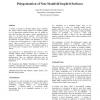Free Online Productivity Tools
i2Speak
i2Symbol
i2OCR
iTex2Img
iWeb2Print
iWeb2Shot
i2Type
iPdf2Split
iPdf2Merge
i2Bopomofo
i2Arabic
i2Style
i2Image
i2PDF
iLatex2Rtf
Sci2ools
138
click to vote
SIGGRAPH
1995
ACM
1995
ACM
Polygonization of non-manifold implicit surfaces
A method is presented to broaden implicit surface modeling. The implicit surfaces usually employed in computer graphics are two dimensional manifolds because they are defined by real-valued functions that impose a binary regionalization of space (i.e., an inside and an outside). When tiled, these surfaces yield edges of degree two. The new method allows the definition of implicit surfaces with boundaries (i.e., edges of degree one) and intersections (i.e., edges of degree three or more). These non-manifold implicit surfaces are defined by a multiple regionalization of space. The definition includes a list of those pairs of regions whose separating surface is of interest. Also presented is an implementation that converts a nonmanifold implicit surface definition into a collection of polygons. Although following conventional implicit surface polygonization, there are significant differences that are described in detail. Several example surfaces are defined and polygonized. CR Categories...
Related Content
| Added | 26 Aug 2010 |
| Updated | 26 Aug 2010 |
| Type | Conference |
| Year | 1995 |
| Where | SIGGRAPH |
| Authors | Jules Bloomenthal, Keith Ferguson |
Comments (0)

